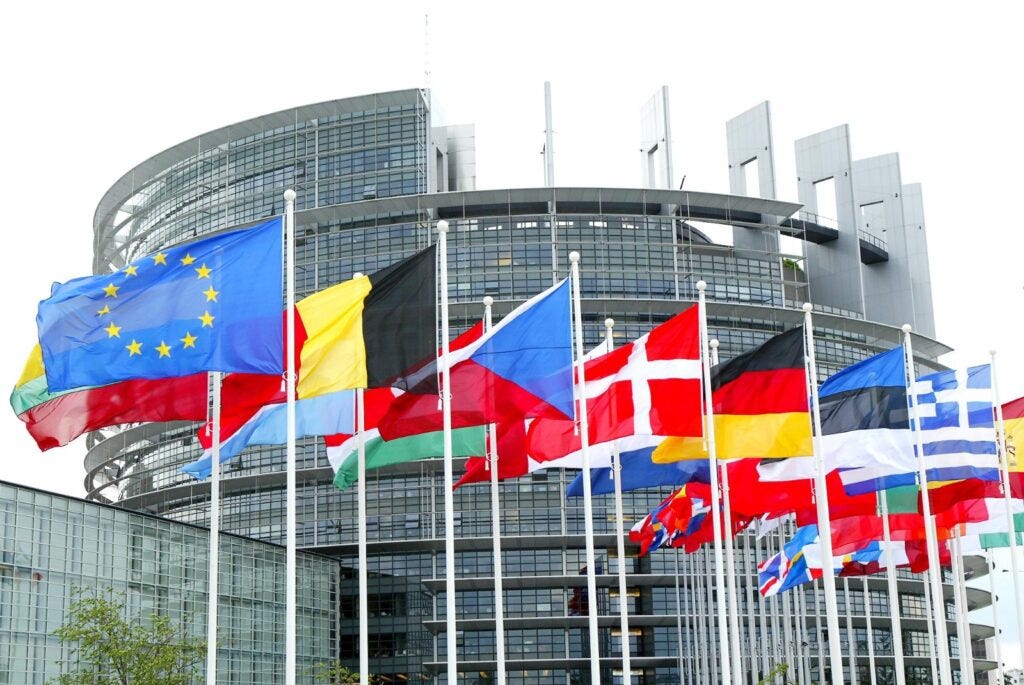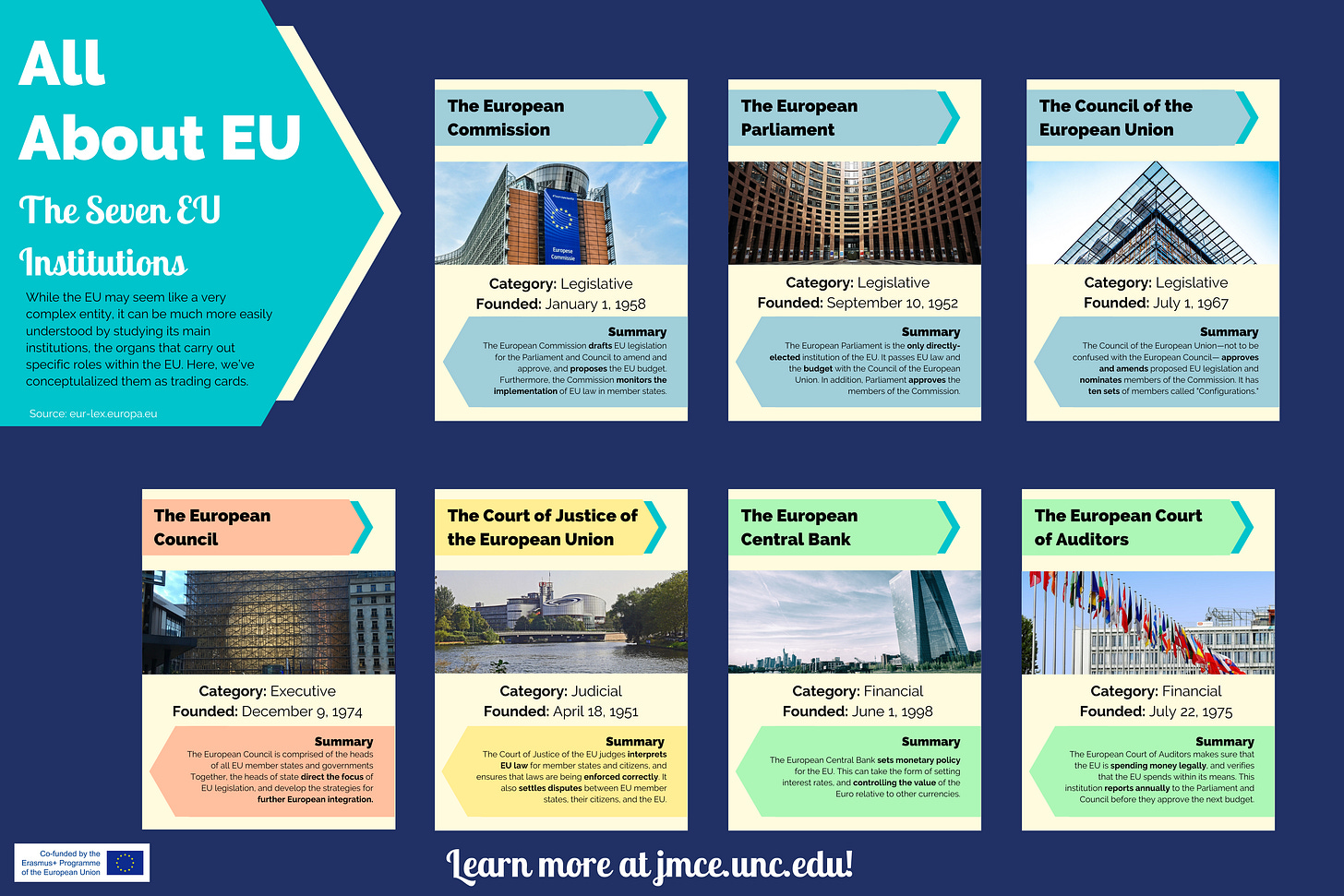Demystifying the European Union
Episode I - Deconstructing EU institutions and the process for passing laws

The European Union (EU) is more and more frequently appearing in headlines these days; whether it be actions regarding Russia’s invasion of Ukraine, Brexit complexities or interest rate rises. But, like many people, you might not really have spent much time thinking about the EU, and now that you can’t seem to escape it in the news, have some questions you want answered, such as:
What exactly is the EU?
Who are its people and what are its institutions?
How does it pass laws and make policies?
What powers does it have (and not have)?
How does it actually make stuff happen? (e.g., act on policies)
What are the most important EU rules and their pros and cons (e.g., freedom of movement, single market)?
How does it compare to other Unions (e.g., United States of America)?
Unfortunately, in my experience, it is pretty hard to find simple answers to these questions. Instead, you have to navigate the maze of official EU websites and resources to get the information you need. With this post, which covers the first three questions in bold above, and the posts that follow, I hope to fill this void with a short, accessible introduction to the EU.
Disclaimer: This article is based primarily on official EU resources, but I am not an expert on the EU
So, remind me, what is the EU again?
A Union of 27 Member States (i.e., EU countries) that sacrifice some of their individual sovereignty (authority over their actions) to certain EU institutions. These institutions are collectively operated by those Member States and their representatives. At the core of the EU concept is the idea that there’s ‘strength in numbers’ (i.e., individual Member States get more in return if they transfer some of their decision-making power to a collective).
The European Union is made up of countries that have transferred some of their power to EU institutions with the hope of increasing their returns from the results of collective action.
Who or what wields this collective power and makes the decisions?
Most of the power is wielded by the seven EU institutions. They are:
The European Commission (= the ‘Commission’)
Who: A President (political leader) and 27 Commissioners (one from each Member State) that make up the College of Commissioners, all of whom are approved by the Parliament and Council below. Each Commissioner leads a specific policy area (e.g., Agriculture or Economy).
What: Essentially the government of the EU. It is organised into different departments (called Directorates-General, or DGs) that develop, implement and manage EU laws and policies
The European Parliament (= ‘Parliament’)
Who: A group of politicians (referred to as Members of the European Parliament, or MEPs) elected by voters in each Member State
What: They vote on legislation (laws, regulations or policies) proposed by the Commission and hold them to account, with the power to adopt a vote of no confidence in the Commission and dismiss the appointed leaders.
The Council of the European Union (= the ‘Council’)
Who: 10 ministers from each Member State (270 in total)
What: 10 departments (e.g., agriculture), called configurations, each with 27 members (one from each Member State). They vote on legislation proposed by the Commission (approval from both the Council and Parliament are needed to pass legislation)
Who: Heads of state from each Member States (e.g., Prime Minister or Chancellor), a President (a Member State that rotates every 6 months) and the President of the Commission
What: Similar to a government cabinet or executive branch. It gives guidance in emergency situations and on issues that are particularly sensitive, such as foreign and defence policy, and nominates the President of the Commission.
The Court of Justice of the European Union
Who: One judge from each Member State and 11 ‘advocates general’ (similar to advisors)
What:
Ensures EU institutions make policies that are legal as according to the Treaties (similar to constitution) of the EU
Establishes that Member States are complying with their obligations as specified in the Treaties
Provides judgement on how European Law should be interpreted if there is disagreement between Member States, citizens and/or EU institutions
Who: An executive board of 6 economists, and the governor of the central bank of each member of the Eurozone
What: The central bank of the 20 Member States using the Euro currency. It:
Tries to keep inflation in the Eurozone within a certain target range
Ensures banks act responsibly
Monitors the Eurozone financial system and maintains financial stability (e.g., makes sure money comes out of the ATM even in financial crises)
Who: One representative from each Member State
What: Audits the EU budget, both in terms of money coming in and money out (i.e., collects data on income and spending by the EU, analyses it and provides reports for other EU institutions to use)

How much do these institutions work together vs. independently?
The latter three of the above institutions (Court of Justice, Central Bank, Court of Auditors) work relatively independently from the rest. However, the first 3 (Commission, Parliament, Council of Europe) work closely together to develop legislative proposals, refine them and get them approved.

So, how do the European Commission, European Parliament and Council of Europe *normally* work together to pass laws?
In the Ordinary Legislative Procedure (i.e., the normal path for laws, regulations and policies to be introduced), only the Commission can draft and submit a legislative proposal. They can do this of their own initiative, or other institutions/groups can request the Commission to submit a proposal on a topic (e.g., the Central Bank, Parliament or even a group of citizens).
To begin the proposal, the Commission (i.e., a group of staff within a specific DG) will define the change proposed and research the pros and cons of the change. In this process, Commission teams may speak to experts, Member State government departments, EU institutions and non-governmental organisations (NGOs) working in the area for more information. They compile this information into an impact assessment report, which forms part of the legislative proposal.
There are a number of forms that a proposal following the ordinary procedure can take:
A regulation is a legally binding rule that all EU Member States must adhere to
A directive specifies an end result each Member State must achieve, though leaves it open as to how they achieve it
A decision applies to specific EU institutions or Member States, for example the decision to allow Croatia to join the Eurozone, or on how EU institutions should combat future cross-border threats like pandemics
When the Commission team have finished the proposal, they submit it to the Council and Parliament. These are the two institutions that have the power to pass, reject or demand amendments to the proposal.
Upon receiving the proposal, the European Parliament and the Council will normally assign it to one of their committees or working groups to consider. These committees take a position on the proposal, and the Parliament or Council vote on this position.
Usually, the European Parliament vote on their position first (during their ‘first reading’). Then, the Council, on their first reading, will decide whether they agree with Parliament, or require changes. If no changes are required, the proposal is adopted and signed by the Presidents of the Council and Parliament. If changes are required, the proposal goes back to Parliament for a second reading.
For Parliament to adopt a proposal, >50% of the MEPs need to vote yes (simple majority)
For the Council to adopt a proposal, >55% of Council members who represent >65% of the EU population need to vote yes (double majority)

Sometimes, the Commission may send the proposal to national parliaments of Member States (e.g., the German or Irish parliament) or specialist committees (e.g., ones that focus on the social impact of proposals) and request their input. Feedback from countries or committees can then be incorporated into future drafts of the proposal.
If the Council and Parliament cannot agree on the text of a new law, they may require a Conciliation Committee to be set up, which is a group of people from the Council and Parliament chosen to represent them in negotiations. If they can agree on a joint text, the proposal progresses. If not, it dies.
What is an example of a recent proposal that passed?
The EU adopted a decision using Ordinary Legislative Procedure on the day Russia invaded Ukraine.
The process started on 1st February 2022, three weeks before the invasion. The European Commission submitted a 34-page draft to the Council and Parliament proposing the EU provide rapid financial aid (€1.2 billion) to Ukraine in response to the security threats Russia posed on the border. They also submitted it to the national parliaments of each Member State for review.
The European Parliament approved the proposal on its first reading on 16th February. The Council had three sets of discussion on the proposal over three weeks and approved the European Parliament’s position on 21st February.
The actual process of approving legislation can involve a series of votes on proposed amendments to the draft of the legislation, before a final vote on the proposal itself
On 24th of February, the day of the Russian invasion of Ukraine, the President of the European Parliament and the President of the Council signed the decision.

But what about the European Council (not the Council of Europe!). Since this is the group of political leaders from all the Member States, surely it has (or should have) the most power?
The European Council, which meets at least 4 times in every 12 month period, mostly provides direction to other institutions, though in some cases it plays a more active role.
To give direction, the European Council publishes statements (conclusions) and long-term strategies about what direction they believe the EU should be heading (e.g., what structural reforms are required, how the EU should develop further). Other institutions like the Commission and Parliament are supposed to heed this advice and follow in the general direction set by the European Council. To ensure this actually happens, the European Council sometimes sets deadlines for other EU institutions to achieve these goals (e.g., by saying X legislation should be passed by Y date). However, the European Council is not normally involved in the legislative (law-making) process, and therefore cannot act to force laws to pass.
The European Council usually acts by consensus (assume they are in agreement unless a Member actively opposes), but sometimes they vote on issues (this tends to be the more important topics) and even require unanimous agreement (like a new country joining the EU)
There are a few exceptions to this framing of the European Council as an advisory type of institution (some, but not all, are listed here). It also:
Defines the EU defence policy (e.g., border control) and gives guidance on how it should be implemented
Nominates people to positions of power in important EU institutions, such as the president of the European Commission and European Central Bank
Decides EU policy in crisis situations (e.g., financial crisis, Brexit, etc. )
Sets the terms for EU enlargement, i.e., the conditions of new countries joining the EU
Initiates the procedure to suspend a Member State, though this must be approved by the European Parliament
Until next time (Episode II)…!
The above describes in broad terms the main EU institutions and how laws, regulations and policies are normally passed. There are of course other EU institutions that were not discussed and never-ending exceptions to the normal legislative process.
If you see any errors or have suggestions for improvements, please let me know or comment below.
Next time, we’ll focus on what powers the EU has and how it actually makes stuff happen!



